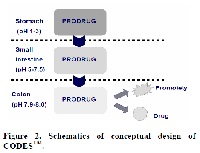Primary and novel approaches for colon targeted drug delivery – A review
Keywords:
Colon drug delivery systems, Primary approaches, Newly developed approaches, evaluation of colon targeted drug delivery systemsAbstract
The colon is a site where both local and systemic delivery of drugs can take place. Local delivery could, for example, allow topical treatment of inflammatory bowel disease. Treatment could be made more effective if it were possible for drugs to be targeted directly on the colon. Systemic side effects could also be reduced. Colon specific systems might also allow oral administration of peptide and protein drugs, which are normally inactivated in the upper parts of the gastrointestinal tract. Primary approaches for CDDS (Colon Specific Drug Delivery), which includes prodrugs, pH and time dependent systems and microbially triggered drug delivery system achieved limited success and having limitations. Newly developed CDDS, which includes pressure controlled colonic delivery capsules (PCDCS), CODESTM and osmotic controlled drug delivery are unique in terms of achieving in vivo site specificity and feasibility of manufacturing process. This review also focuses on evaluations of CDDS in general.
References
Adkin DA, Davis SS, Sparrow RA, Wilding IR.
Colonic transit of different sized tablets in
healthy subjects. Journal of Controlled Release.
; 23: 147- 156.
Ahrabi SF, Madseh G, Dyrstad K, Sande SA,
Graffner C. Development of pectin matrix tablets
for colonic delivery of model drug ropivacanie.
European Journal of Pharmaceutical Sciences.
; 10: 43-52.
Ahmed S. Effect of simulated gastrointestinal
condition on drug release from pectin/ethyl
cellulose as film coating for drug delivery to the
colon. Drug Development and Industrial Pharmacy.
; 31: 465-470.
Aiedeh K. Taha MO. Synthesis of chitosan
succinate and chitosan phthalate and their
evaluation as suggested matrices in orally
administered colon specific drug delivery system.
Arch. Pharmacol. Research. 1999; 332: 103-107.
Akala EO, Elekwachi O, Chase V, Johnson H,
Marjorie L, Scott K. Organic redox initiated
polymerization process for the fabrication of
hydrogel for colon specific drug delivery. Drug
Development and Industrial Pharmacy. 2003;
(4): 375-386.
Ashord M, Fell JT, Attwood D, Sharma H,
Woodhead P. An evaluation of pectin as a carrier
for drug targeting to the colon. Journal of
Controlled Release. 1993a; 26: 213-220.
Asford M, Fell JT, Attwood D, Sharma H,
Woodhead PJ. Studies on pectin formulations for
colonic drug delivery. Journal of Controlled
Release. 1994; 30: 225-232.
Hita V, Singh R, Jain SK. Colonic targeting of
metronidazole using azo aromatic polymers,
development and characterization. Drug delivery.
; 4: 19-22.
Basit A, Bloor J. Prespectives on colonic drug
delivery. Business briefing: Pharmtech. 2003; 185-
Bussemer T, Otto Bodmeier IR. Pulsatile drugdelivery systems. Crit. Rev. Ther. Drug Carrier
System. 2003; 18: 433-458.
Chan RP, Pope DJ, Gilbett AP, Sneta PJ, Baron JH,
Bennardjones JF. Studies of two novel
sulphasalazine analogs I.P. salazide and
balsalazide. Digestive Diseases Sciences. 1983; 28:
-716.
Chavan MS, Sant VP, Nagarsenker MS. Azocontaining urethane analogues for colonic drug
delivery: synthesis, characterization and in vitro
evaluation. Journal of Pharmacy Pharmacology.
; 53: 895-900.
Jung YJ, Lee JS, Kim HH, Kim YK, Han SK.
Synthesis and evaluation of 5-
aminosalicylicylglycine as a potential colon
specific prodrug of 5-aminosalicylic acid. Arch.
Pharmacol. Research. 1998; 21: 174-178.
Vandelli MA, Leo E, Forni F, Bernabei MT. In
vitro evaluation of a potential colonic delivery
system that releases drug after a controllable lagtime. European Journal Pharm. Biopharm. 1996;
: 148-151.
Cole E, Scott R, Connor A, Wilding I, Petereit HU,
Schminke C, Beckert T, Cade D. Enteric coated
HPMC capsules designed to achieve intestinal
targeting. International Journal of Pharmaceutics.
; 231: 83-95.
Cummings JH, Englyst HN. Fermentation in the
human large intestine and available substrates.
American Journal of Clinical Nutrition. 1987; 45:
-1255.
Cui N, Friend DR, Fedora RN. A budesonide
prodrug accelerates of colitis in rats. Gut. 1994; 35:
-1446.
Davis SS, Hardy JG, Fara JW. Transit of
pharmaceutical dosage forms through the small
intestine. Gut. 1986; 27: 886-892.Tiwari et al. International Journal of Drug Delivery 2 (2010) 01-11
Evans DF, Pye G, Bramley R, Clark AG, Dyson TJ,
Hardcastle JD. Measurement of gastrointestinal pH
profiles in normal ambulant human subjects. Gut.
; 29: 1035-1041.
Tozaki H, Komoike J, Tada C, Maruyama T,
Terabe A, Suzuki T, Yamamoto A, Muranishi S.
Chitosan capsules for colon-specific drug delivery:
improvement of insulin absorption from the rat
colon. Journal of Pharmaceutical Sciences. 1997;
: 1016-1021.
Friend DR, Chang GW. A colon-specific drug
delivery system based on drug glycosides and
glycosidase of colonic bacteria. Journal of
Medicinal Chemistry. 1984; 27: 261-266.
Friend DR, Chang GW. Drug Glycosides: Potential
prodrugs for colon specific drug delivery. Journal
of Medicinal Chemistry. 1985; 28: 51-57.
Friend DR, Phillip S, Tozer TN. Colon specific
drug delivery from a glucosidic prodrug in the
guinea pig efficacy study. Journal of Controlled
release. 1991; 15: 47-54.
Fukui E, Miyamura N, Kobayashi M. An in vitro
investigation of the suitability of presscoated tablets
with hydroxypropylmethylcellulose acetate
succinate (HPMCAS) and hydrophobicn additives
in the outer shell for colon targeting. Journal of
Controlled Release. 2001; 70: 97-107.
Fukui E, Miyamura N, Verma K, Kobayashi M.
Preparation of enteric coated time released press
coated tablets and evaluation of their function by in
vitro and in vivo tests for colon targeting.
International Journal of Pharmaceutics. 2000; 204:
-15.
Gazzaniga A, Iamartino P, Maffino G, Sangalli
ME. Oral delayed release system for colonic
specific drug delivery. International Journal of
Pharmaceutics. 1994; 108: 77-83.
Hata T, Shimazaki Y, Kagayama A, Tamura S,
Ueda S. Development of a novel drug delivery
system, time-controlled explosion system (TES).
Part 5 Animal pharmacodynamic and human
bioavailability studies. International Journal of
Pharmaceutics. 1994; 110: 1-7.
Hay DJ, Sharma H, Irving MH. Spread of steroid
containing foam after intrarectal administration.
British Medical Journal. 1979; 1: 1751-1753.
Hay DJ, Wilson I, Hardy JG, Frier M, Davis S.
Radionuclide imaging in drug research.
Croomhelm, London. 1982; 171 – 180.
Hergenrother RW, Wabewr HD, Cooper SL. The
effect of chain extenders and stbilizers on the in
vivo stability of polyurethanes. Journal Appllied
Biomat. 1992; 3: 17-22.





